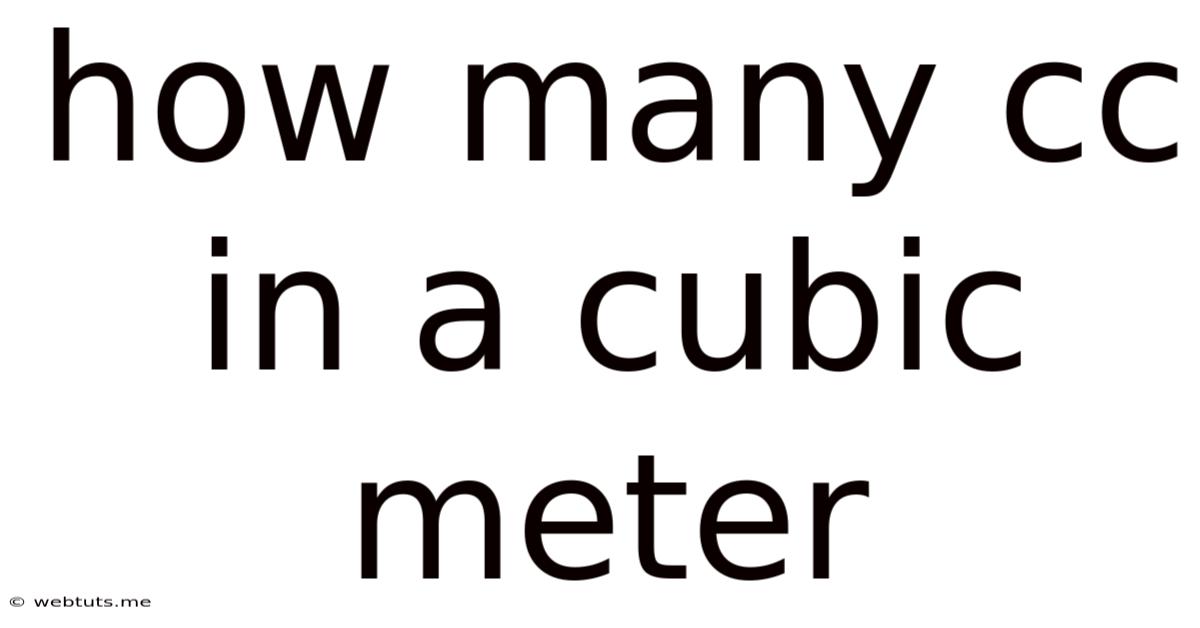How Many Cc In A Cubic Meter
Webtuts
May 11, 2025 · 4 min read

Table of Contents
How Many CCs in a Cubic Meter? A Comprehensive Guide to Cubic Centimeters and Cubic Meters
Understanding unit conversions is crucial in various fields, from engineering and construction to medicine and everyday life. One common conversion that often causes confusion is the relationship between cubic centimeters (cc) and cubic meters (m³). This comprehensive guide will delve deep into this conversion, exploring the underlying principles, providing clear explanations, and offering practical examples to solidify your understanding.
Understanding Cubic Centimeters (cc) and Cubic Meters (m³)
Before diving into the conversion, let's first define each unit:
Cubic Centimeter (cc or cm³)
A cubic centimeter (cc or cm³) represents the volume of a cube with sides measuring one centimeter (cm) each. It's a relatively small unit of volume, often used for measuring the volume of liquids, small containers, or the displacement of engines. The terms "cc" and "cm³" are used interchangeably.
Cubic Meter (m³)
A cubic meter (m³) is the volume of a cube with sides measuring one meter (m) each. It's a significantly larger unit of volume, commonly used for measuring larger spaces like rooms, buildings, or the capacity of storage containers.
The Conversion Factor: From cc to m³ and Vice Versa
The key to converting between cc and m³ lies in understanding the relationship between centimeters and meters. One meter is equal to 100 centimeters (1m = 100cm). Therefore, when considering volume (which is a three-dimensional measurement), we need to cube this relationship.
This leads to the following crucial conversion factors:
- 1 m³ = 1,000,000 cm³ (or 1,000,000 cc)
- 1 cm³ (or 1 cc) = 0.000001 m³
This means that one cubic meter is equal to one million cubic centimeters. Conversely, one cubic centimeter is equal to one-millionth of a cubic meter. These are fundamental conversion factors that will be used throughout the rest of this guide.
Practical Applications and Examples
Let's look at some real-world examples to demonstrate how to apply this conversion:
Example 1: Converting Cubic Meters to Cubic Centimeters
Imagine you have a water tank with a volume of 2.5 m³. To find the volume in cubic centimeters, we use the conversion factor:
2.5 m³ * 1,000,000 cm³/m³ = 2,500,000 cm³
Therefore, a 2.5 m³ water tank has a volume of 2,500,000 cubic centimeters.
Example 2: Converting Cubic Centimeters to Cubic Meters
Let's say you have a container holding 500,000 cc of liquid. To convert this volume to cubic meters, we use the conversion factor:
500,000 cm³ * 0.000001 m³/cm³ = 0.5 m³
Therefore, a container holding 500,000 cc of liquid has a volume of 0.5 cubic meters.
Example 3: Engine Displacement
Engine displacement is often measured in cubic centimeters (cc) or liters (L). Knowing the conversion between cc and m³ helps bridge the gap between these units and other larger volume measurements. A car engine with a displacement of 1500 cc has a volume of:
1500 cm³ * 0.000001 m³/cm³ = 0.0015 m³
Example 4: Calculating the Volume of a Room
Let's say you need to calculate the volume of a room for ventilation purposes. The room measures 4 meters long, 3 meters wide, and 2.5 meters high. The volume in cubic meters is:
4 m * 3 m * 2.5 m = 30 m³
To convert this to cubic centimeters:
30 m³ * 1,000,000 cm³/m³ = 30,000,000 cm³
This demonstrates the vast difference in scale between cubic meters and cubic centimeters.
Common Mistakes to Avoid
When working with unit conversions, it's easy to make mistakes. Here are some common errors to watch out for:
- Incorrect Conversion Factors: Ensure you're using the correct conversion factor (1 m³ = 1,000,000 cm³). Using an incorrect factor will lead to completely wrong results.
- Misplacing the Decimal Point: When working with very large or very small numbers, it's easy to misplace the decimal point. Double-check your calculations carefully.
- Mixing Units: Avoid mixing units within a single calculation. Make sure all measurements are in the same units (either cm or m) before performing any calculations.
Beyond the Basics: Advanced Applications
The conversion between cubic centimeters and cubic meters has applications beyond simple volume calculations. It's an integral part of:
- Fluid Mechanics: Engineers use this conversion when dealing with fluid flow, pressure, and other related concepts.
- Material Science: This conversion is important in calculating the density and volume of various materials.
- Medical Applications: In medical imaging and treatment, precise volume measurements are essential, and this conversion plays a vital role.
- Construction and Engineering: Calculating volumes of materials, spaces, and structures often requires converting between cc and m³.
Conclusion: Mastering the Conversion
Mastering the conversion between cubic centimeters and cubic meters is a fundamental skill in various disciplines. Understanding the conversion factor (1 m³ = 1,000,000 cm³) and practicing with different examples will solidify your understanding and prevent common errors. By understanding this relationship, you can confidently tackle various problems involving volume calculations, regardless of the units used. Remember to always double-check your calculations and ensure consistency in units for accurate results. This conversion is a cornerstone of many scientific and engineering calculations, so mastering it will empower you to handle a wide range of practical problems with ease.
Latest Posts
Latest Posts
-
What Is 40 Oz In Cups
May 12, 2025
-
Ratio Of Cement Sand And Gravel
May 12, 2025
-
How Many Liters Is 9 Cups
May 12, 2025
-
Number Of Tablespoons In 1 3 Cup
May 12, 2025
-
How Many Days Till The 13th
May 12, 2025
Related Post
Thank you for visiting our website which covers about How Many Cc In A Cubic Meter . We hope the information provided has been useful to you. Feel free to contact us if you have any questions or need further assistance. See you next time and don't miss to bookmark.